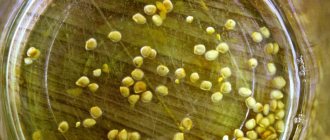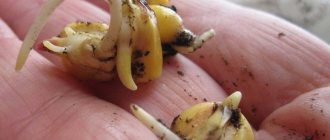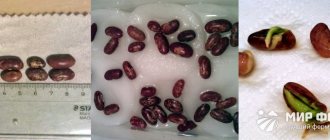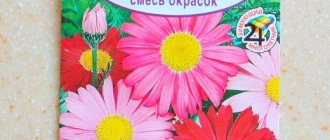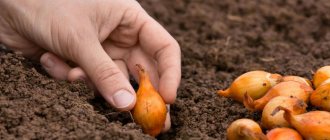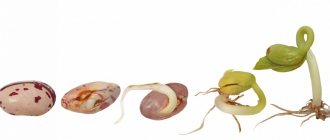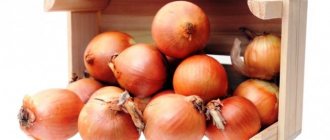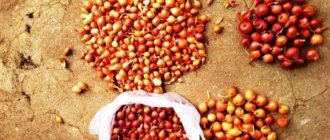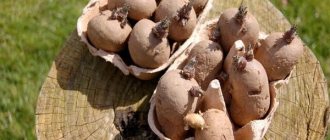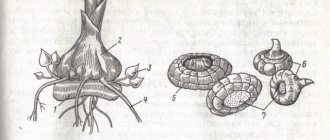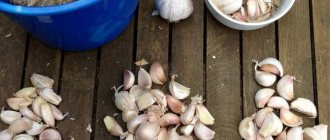The benefits of cucumbers have been known for a long time. These vegetables act as a choleretic, diuretic and laxative; they help reduce cholesterol levels in the body; they are often consumed during a diet for weight loss. Thanks to these and many other beneficial properties, as well as their taste, summer residents and gardeners often plant cucumbers on their plots.
There are many ways to grow these vegetables. This article describes how to germinate cucumber seeds, what is required for this, and what care the seedlings need to provide.
Is it necessary to germinate
Germinating seeds before planting is the key to getting a rich harvest. Cucumber seeds germinate without preliminary preparation, but there are situations when it is necessary:
- you need to know the percentage of germination;
- there is no time to replant unsuccessful crops;
- friendly, even-aged seedlings are required.
The viability of cucumber embryos lasts only two years, so purchasing seeds that have been stored longer is not recommended.
Advantages and disadvantages
The following advantages of the procedure are highlighted:
- Selection of quality grains. During soaking, you can see which of them will grow better than others. The bad ones get rid of immediately.
- Friendly germination. Sprouted grains germinate simultaneously, 8-10 days after sowing.
- Protection against diseases. During soaking, the seeds become strong, and plants grown from them are rarely susceptible to fungal and viral diseases.
The main disadvantage of the process is its complexity, which is why some gardeners do not use it.
When approximately do cucumbers sprout under different conditions?
The most important factor for the rapid germination of cucumber seeds is temperature.
At a soil temperature of +12-13 ºС, cucumber seeds begin to germinate. The most suitable temperature is +20-25 ºС; under these conditions, cucumbers will hatch in 4-5 days. At temperatures below +18 ºС, seedlings should be expected no earlier than 10 days later.
If 2 weeks have passed and the sprouts have not appeared, it is recommended to re-sow.
It is also worth considering that fresh seeds germinate poorly, and old ones may not germinate at all. Seeds 1-2 years old have the highest germination rate.
Growing cucumbers on your own plot is not difficult, but this process requires some knowledge
It is important to choose and calibrate the seed correctly, maintain humidity conditions and sow seeds at a temperature favorable for their germination. And then friendly, strong shoots of cucumbers will not take long to arrive, and the harvest will be plentiful
- What to plant next to cucumbers: friends and enemies of culture
- Small but insidious: spider mites on cucumbers
- Powdery mildew on cucumbers
- How to get rid of ants in a cucumber garden without harming yourself
- Downy mildew on cucumbers
- Anthracnose of cucumbers
Preparing for germination
Before the procedure, planting material is carefully prepared.
Calibration
Select grains from healthy plants that are not affected by diseases. If these are not available, you will have to purchase them at a garden store.
When selecting, the following nuances are taken into account:
- the background should be green;
- the grains must be from the female type of plant, as they will give a good harvest;
- The planting material must be completely dry, dense and complete before planting.
To prepare a saline solution, pour 3-5 g of salt into 100 ml of water, then drop the seeds into it. Those that float up are empty, they are thrown away.
Why is seed calibration needed? It's easy to check the germination of seeds!
Sterilization
Plant diseases are transmitted along with planting material, so the sterilization stage is important. They refuse it only if they use purchased seeds.
Homemade seeds are sterilized in this way:
- Take a 1% solution of potassium permanganate and immerse the grains in it.
- The water in the solution should be warm – +20-26°C.
- Keep the seeds in the solution for 15-20 minutes, then wash them under running water.
There is a second method of sterilization - heating. Planting material is immersed in warm water (+50°C) and the grains are kept for 20-30 minutes. This time is enough to get rid of viruses or fungi remaining on the seeds.
Hardening
It is necessary if the seeds are planted directly in open ground. The air temperature will be low, so it will be difficult for the plant to adapt to weather conditions. If you plant seeds in the hot season, hardening will not be required.
Attention! Hardening begins on the first day after placing the seeds in containers for germination.
Procedure:
- The container is placed in the refrigerator at a temperature of 4-6°C for 12 hours so that the planting material adapts to the conditions. You can do this at night.
- Similar manipulations are carried out for 2-3 days until the seeds germinate.
Bubbling
Allows you to accelerate the emergence of seedlings. The essence of bubbling is to saturate the planting material with oxygen, which has a positive effect on overall germination.
To do this, you will need an aquarium compressor and a container of 0.5-0.7 liters, or a regular glass jar.
Procedure:
- Fill the container 1/4 full with water.
- Dip a small amount of grains into the water so that they float freely in the jar.
- Lower the compressor tip to the bottom of the container and turn it on.
- This processing of grains lasts for 18 hours.
- After bubbling, dry the planting material.
The process increases germination rate to 100% and guarantees rapid seed germination - in 3-7 days.
I SOAK CUCUMBER SEEDS TO GET AN EARLY HARVEST. Olga Chernova.
How many days will it take to expect the first shoots?
When optimal conditions are created after soaking, cucumber seeds hatch already on the third to fifth day.
Expert opinion
Stanislav Pavlovich
Gardener with 17 years of experience and our expert
Ask a Question
It must be taken into account that different varieties and hybrids germinate unevenly over time. Place them in different containers.
Important! Seedlings are planted in the ground only after stable warm weather has established. In conditions of frequent temperature fluctuations, a film cover is provided.
Methods for germinating cucumbers
Let's take a closer look at how and with what help they are carried out.
On paper
You can use regular toilet paper, as it contains components that have a beneficial effect on plant growth. This includes cellulose and other polysaccharides that act as organic fertilizer.
First, the paper is spread on a flat surface and sprayed with water. Afterwards, lay out the seeds and cover with film, roll the paper into a roll. After 2-3 days, the grains will begin to hatch.
On a damp cloth
For these purposes, you will need a damp cloth on which the seed is carefully laid out. Sprinkle the seeds with warm water on top and cover them with another piece of damp cloth. Germination lasts 4-5 days.
In the peat
A peat tablet is compressed peat in the shape of an oval puck. There are small holes on the surface into which the seeds are placed. But before using peat tablets, they are placed in a container with water and kept there for 10 minutes.
When their size increases 2-3 times, grains are placed in the holes and sprinkled with peat on top.
For germination, take special peat pots. They are filled with a soil mixture consisting of soil, organic and mineral fertilizers. Next, holes are made in the soil and cucumber seeds are planted in them.
In a rolled-up cigarette
This is a relatively new method, thanks to which strong seedlings are obtained.
Reference. This method can be used not only for cucumbers, but also for other vegetable crops.
Procedure:
- Polyethylene film is spread on the surface, paper is placed on top and water is poured over it.
- Lay out the seeds so that there is a distance of 4-6 cm between them.
- Roll the paper-polyethylene strip into a roll and wait for the seeds to germinate.
In coconut substrate
To prepare the substrate, take shavings and coconut fibers. Before use, coconut tablets are soaked in boiling water to swell, and then the seeds are planted.
All not
Procedure:
- Pour boiling water over the hay, and while it is still hot, place it in a suitable container.
- Lay out the seeds, keeping a distance of 2 cm, cover them with a thin layer of hay.
- The container with hay is covered with plastic wrap and the container is placed in a warm place where the air temperature will not be lower than +25°C.
Advice from experienced gardeners
Growing vegetables requires knowledge of the subtleties of care.
Some tips from experienced summer residents:
- When planting cucumbers, it would be wrong to talk about specific dates, since each region has its own climate nuances, so those days are suitable when the soil has warmed up to +10°C at night.
- When planting under a bottle, be sure to make a hole for ventilation so that the crop does not suffocate.
- When covering a seed with a bottle, you should not press it too hard into the soil, otherwise when the cover is removed, it may pull the entire bush with it.
- It is necessary to take into account that covering with a bottle is not enough; you will still have to cover it with film so that the soil warms up evenly, and not just in the cut diameter of the mini-shelter.
- During subsequent care, you need to carefully monitor watering, since cucumber is a moisture-loving crop. The mulching procedure will help you save your own care time: it will retain moisture, prevent the growth of weeds, and protect from overheating. The soil should not be allowed to dry out, as this will cause the fruits to become bitter.
- The most important procedure is loosening, since the root system of cucumbers must have access to air. But you need to loosen shallowly so as not to damage the surface roots.
- To ensure that all fruit ovaries have enough light, you need to tie up the lashes.
- When watering or fertilizing, the liquid should be poured into the hole, under the root. Moisture that gets on the foliage will cause sunburn.
Requirements
For 100% germination of grains, it is important to comply with the following conditions: temperature, humidity, lighting, and also protect them from pests.
Temperature
Cucumber seeds should be kept at a temperature no higher than +25-26°C and no lower than +20°C. If temperatures are high, this will slow down seed hatching and prevent seedlings from fully developing.
Lighting
Cucumbers are a light-loving crop, so seedlings should be in a well-lit place. Shaded places on the site are not suitable - there the seedlings will grow slowly.
Watering
Cucumbers must be moistened from time to time, otherwise their growth will stop. Water them three times a week using warm water.
Protection of crops from pests and diseases
Regular treatment of plants with drugs will help prevent the development of diseases and the appearance of pests:
- "Ordan";
- "Baktofit";
- "Fitolavin".
Treatment is carried out in the evening or early in the morning.
conclusions
If all the above conditions are met, then in a few days strong and healthy seedlings will appear.
For normal seedling growth, warmth and good lighting are required.
After this, the containers can be placed on window sills or insulated balconies. In this case, the seedlings will receive the right amount of light. In cloudy weather, seedlings must be illuminated with phytolamps . If the weather is sunny outside , then it is better to cover the window on which the pots with seedlings stand with newspapers or paper. This will prevent direct sunlight from damaging young plants.
Sowing cucumber seeds is quite simple, but there are many reasons for poor seed germination. But if you take into account the recommendations of experienced farmers when choosing planting material and soil for planting, and follow all stages of germination, this will save time and make it possible to obtain strong and healthy seedlings.
How to speed up the process
To make the seeds germinate faster, you can use the following medications:
- "Kornevin". The product is suitable not only for stimulating growth, but also for protecting against diseases. To obtain a solution, combine 2 liters of water and 2 g of the drug. Treat seeds once every 2-3 days before planting.
- "Silk." Activates the development of vegetables and increases their productivity. The drug protects crops from fungal diseases.
- Sodium humate. Add 55 g of the drug to 5 liters of warm water. Before use, the composition should sit for 5-6 hours.
What to do if the seeds do not hatch and what are the reasons?
This problem arises when using low-quality seed material. Pecking may slow down if vegetables are grown in a cool and poorly lit place. It is necessary to normalize the growing conditions and, if there is no result, repeat the procedure using high-quality seeds.
